#the university grants commission act
Text



On August 1st 1967 Queen's College in Dundee became a fully fledged university in its own right and was renamed the University of Dundee.
The history of what would become Dundee University stretches back to 1881 when University College Dundee was founded. Its creation owed much to the wealth gathered in Dundee through the jute and textile industry.
The prospect of establishing a university in Dundee had been under discussion since the 1860s. It was made a reality with a donation of £120,000 from Miss Mary Ann Baxter, of the hugely wealthy and influential Baxter family. Her cousin, John Boyd Baxter, the Procurator Fiscal for Dundee District of Forfarshire, was heavily involved in the discussions and also donated monies.
As the main benefactor and co-founder, Miss Baxter had definite ideas about how she would like the college to run and took an active role in ensuring her wishes were fulfilled. The deed establishing University College stated that it should promote “the education of persons of both sexes and the study of Science, Literature and the Fine Arts”. As well as promoting the education of both sexes, Miss Baxter insisted it should not teach Divinity, and was adamant that those associated with the university did not have to reveal their religious leanings.
Baxter’s role in establishing University College, Dundee was noted at the time by Scotland’s most notorious poet, who has always had an association with the city, William Topaz McGonagall who wrote:
Good people of Dundee, your voices raise
And to Miss Baxter give great praise;
Rejoice and sing and dance with glee
Because she has founded a College in Bonnie Dundee
University College, Dundee became part of St Andrews University in 1897, under the provisions of the Universities Scotland Act of 1889. This union served to “give expression to local feeling that there should be a vital connection between the old and the new in academic affairs.”
Initially, the two worked alongside each other in relative harmony. Dundee students were able to graduate in science from St Andrews, despite never having attended any classes in the smaller town.
However, over time relations became strained, particularly over the issue of the Medical School and whether chairs of anatomy and physiology should be established in Dundee, St Andrews or both, setting the stage for the tensions that would place some strain on the relationship between the two institutions in the decades ahead.
By the mid-1900s separation was being proposed. A 1954 Royal Commission led to University College being given more independence, being renamed Queen’s College, and taking over the Dundee School of Economics. In 1963, the Committee on Higher Education under the chairmanship of Lord Robbins recommended in its report to Parliament that ‘at least one, and perhaps two, of its proposed new university foundations should be in Scotland’.
The government approved the creation of a university in Dundee, and in 1966, the University Court and the Council of Queen’s College submitted a joint petition to the Privy Council seeking the grant of a Royal Charter to establish Dundee University.
This petition was approved and, in terms of the Charter, Queen’s College became Dundee University on this day in 1967.
To mark the event and the University’s independence the people of Dundee witnessed an unusual event as hundreds of students filed up the Law dressed in red academic gowns. At the top they admired the stunning views – “an arresting vision in crimson” – before heading back down to the newly designated Dundee University.
Fifty years on, and Dundee and St Andrews universities enjoy a warm relationship, very much in the spirit of friendly rivalry. Both are in the world’s top 200 universities and are among the top ranked in the UK for student experience.
The combined strengths of Dundee and St Andrews have been recognised as an “intellectual gold coast” on Scotland’s east side.
Other highlights in Dundee University’s history include the formal merger of Duncan of Jordanstone College of Art with the university in 1994 and the Tayside College of Nursing and Fife College of Health Studies becoming part of the university from September 1, 1996.
And in December 2001 the university merged with the Dundee campus of Northern College to create the Faculty of Education and Social Work.
13 notes
·
View notes
Text
May 24th, 2022 was awards day at Robb Elementary School in Uvalde, Texas. Fourth grader Mayah Zamora won three of them – in math, robotics, and for making the honor roll. Not long after the ceremony, an 18 year-old walked into the school with an AR-15 style Daniel Defense rifle and started shooting.
Nineteen children and two teachers were killed. Zamora was airlifted to the hospital and has had more than sixty surgeries in the year since. Zamora's mom, Christina, says her daughter had been a fearless child before the shooting.
"Mayah shows a fear of this world that she had never shown before," she says. "Someone unexpectedly knocking on the door is a scary trigger for her."
Last year, the Zamoras became the second family to file a lawsuit against law enforcement, the school district, the gun store, and the maker of the weapon, Georgia-based Daniel Defense.
Federal law protects the firearms industry from lawsuits if their products are misused. But the law has exceptions, and the lawsuits allege that Daniel Defense can be held liable for what happened because of how they market their products.
"We need to speak up, for our daughter, for our family, for children in the future, maybe this will make a change," Christina Zamora says. "Nineteen children died. They were massacred. By an 18-year old boy. There's something wrong there."
In 2005, Congress granted broad immunity to gun manufacturers. But some legal experts believe exceptions allow gunmakers to be held partially responsible for these mass shootings if they deceptively marketed their products in violation of the law.
Georgia State University Law Professor Timothy Lytton, an expert on health and safety regulation, says Daniel Defense is notorious for its provocative marketing.
The lawsuits argue that the company violated federal trade law by unfairly marketing its products to civilians as tools for offensive, military-style operations.
"And they also allege that the placement of this AR-15 style weapon in video games allowed young men in particular to fantasize about use of this weapon in a way that would simulate the kind of violence that we saw in Uvalde," Lytton says.
After the Sandy Hook school shooting, some families of the victims made a similar argument in the Connecticut courts against the gunmaker Remington, which was in bankruptcy. And while the families won a seventy-three million dollar payment, it didn't create a sea change.
"It's not like a manufacturer came to the table and said, 'We admit liability here for the carelessness of our marketing practices.' This was a bankruptcy in which bankruptcy creditors paid out in order to get the company back into business," Lytton says.
The U.S. Supreme Court declined to take up the case on appeal. So while gun control supporters cheered the settlement, the litigation left many legal questions unresolved. One big question is whether violations of the Federal Trade Commission Act even apply to the exceptions allowed under that sweeping immunity law. As a result, the Uvalde lawsuits against Daniel Defense could be the biggest test yet of the extent of the firearms industry's liability protections.
The cases have been filed in federal court in Texas, with the help of Everytown Law, an arm of the group Everytown for Gun Safety.
Daniel Defense didn't respond to an interview request, but has called the lawsuit politically-motivated and legally unfounded.
Mark Oliva is managing director of public affairs for the National Shooting Sports Foundation, a trade association for the firearms industry.
"Trying to sue a firearm manufacturer for the crimes committed by a remote third party would be the same thing as trying to sue Ford and Annhauser Bush for the deaths caused by drunk driving," Oliva says.
Even if the Uvalde cases clears the stringent immunity law and are allowed a trial, the courts would still have to consider another set of thorny questions, like whether the company's marketing is protected by the first amendment.
But Lytton says whatever happens, these liability cases put more focus on gunmakers.
"You only need one or two lawsuits to win to transform the whole industry," Lytton says. "If it got planted in Connecticut, and it flowers in Uvalde, that might be enough. And if it never takes root there, it's likely to pop up in Chicago. Or California."
Some states are passing laws that would make it easier to file these suits against gunmakers, but Oliva says the industry is pushing back.
"Are we going to bend to the idea that we're going to suffer death by a thousand cuts? I think your answer to that is we're challenging the law in New York. We're challenging the law in New Jersey. We're challenging the law in Delaware," Oliva says.
Back in Texas, the Zamoras want to make Wednesday's anniversary as normal a day as they can. Right now, they're focused on their daughter's recovery.
But they hope accountability will come, too.
#us politics#news#npr#2023#gun violence#gun rights#gun control#mass shooters#mass shootings#Robb Elementary School#uvalde shooting#Daniel Defense#Mayah Zamora#Christina Zamora#Timothy Lytton#sandy hook shooting#us supreme court#scotus#Federal Trade Commission Act#Everytown for Gun Safety#National Shooting Sports Foundation#school shooting
36 notes
·
View notes
Text
What a truly progressive government looks like
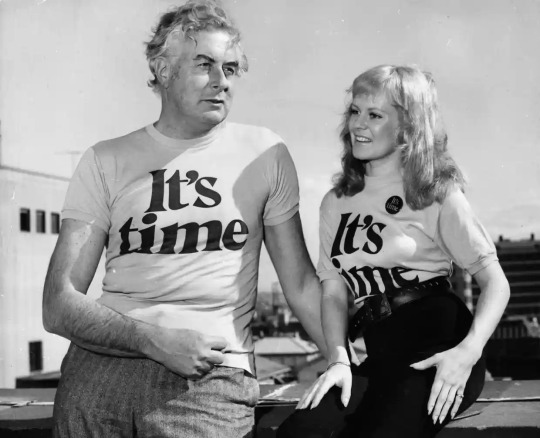
The man in this photo is Gough (pronounced Goff) Whitlam, the 21st prime minister of Australia. Fifty years ago, on 2 December 1972, Gough Whitlam’s Australian Labor Party won the federal election, and ushered in easily the most progressive government Australia has ever had. It was a government that truly changed Australia, and set it on the path towards being the country it is today.
Gough (he was one of those rare politicians who was widely known simply by his first name. There was truly only one Gough) was tall and imposing, with silver hair and dark eyebrows, and a booming voice that delivered his razor sharp wit. When he led the ALP to victory in 1972, the party had been out of government for 23 long years, and were determined to make a difference when at last they were back in power. As you’ve probably worked out from the glorious 1970s t-shirts in the picture, the election campaign slogan was It’s Time. It featured in a famous election ad jingle, performed by Alison McCallum and accompanied by many famous faces of the time.
After winning the 1972 election, Gough wasted no time in implementing his election promises. Not willing to wait until the final results of the election were confirmed and the full ministry could be appointed, he and his deputy, Lance Barnard, were sworn in as prime minister and deputy prime minister on 5 December. Between the two of them, they held all 27 government portfolios for two weeks until the rest of the ministry was sworn in. The duumvirate, as it was known:
ordered negotiations to establish full relations with China
ended conscription in the Vietnam War
freed the conscientious objectors who had been jailed for refusing conscription
ordered home all remaining Australian troops in Vietnam
re-opened the equal pay case (for women, who were at that time by law paid less than men for doing the same job) and appointed a woman, Elizabeth Evatt, to the Commonwealth Conciliation and Arbitration Commission, the body that made the decision
abolished sales tax on the contraceptive pill
announced major grants for the arts
appointed an interim schools commission
barred racially discriminatory sport teams from Australia, and instructed the Australian delegation at the United Nations to vote in favour of sanctions on apartheid South Africa and Rhodesia
And that was just the first two weeks.
In the three years that followed, the Whitlam government:
introduced a national universal health scheme
abolished university fees
abolished the death penalty for federal crimes
established Legal Aid
replaced God Save the Queen with Advance Australia Fair as the national anthem
replaced the British honours system with the Order of Australia
created the family court and introduced no fault divorce, the first country in the world to do so
ended the White Australia policy
introduced the racial discrimination act
advocated for Indigenous rights, including creating the Aboriginal Land Fund and the Aboriginal Loans Commission, and returned some of their traditional lands to the Gurunji people in the Northern Territory. This was the first time that any Australian government had returned land to its original custodians. Here’s a famous photograph by Mervyn Bishop of Gough pouring a handful of red earth into the hands of Gurunji leader Vincent Lingiari, ‘as a sign that this land will be in the possession of you and your children forever‘:

I’m sure there are more achievements of the Whitlam government that I’m forgetting. There were a lot.
Of course, the Whitlam government will always be seen through the lens of the way it ended, but I’m not going to talk about the constitutional crisis of 1975 - plenty of books have been written about that, including one by Gough himself - or about the various dysfunctions of the Whitlam government, particularly once the international oil crisis hit in 1973.
I just really want to point out that truly progressive governments can change their countries profoundly, and for the lasting betterment of their people. Not everything that the Whitlam government achieved withstood the assaults of the conservative government that followed it, but some did and are still with us, half a century later, while other aspects, like universal healthcare, were resurrected by the Hawke Labor government a decade later, and endure to this day.
Gough died in 2014 at the age of 98, not quite making his personal century. Tonight I’m raising a glass to his memory. Thanks, Gough, for all the things you did to make this country a better, fairer, more inclusive place.
80 notes
·
View notes
Text
24 Days of La Fayette: December 1st - Edmund Brice
Edmund Brice was on of La Fayette’s earliest aide-de-camps but not among the most famous ones. He is however one of the men that we still have the Acts of Embarkation of. In France at the time there were strict laws regarding religion. Huguenots (who, in very simple terms, were not Catholic) were prohibited from leaving the country. To enforce this law, every French person who wanted to leave France had to attest their Catholicism. Edmund Brice was one of La Fayette’s fellow travellers on La Victoire and therefor had to go through the same process. These Acts contain a lot of mistakes, sometimes because the clerk misspelled or misinterpreted information and sometimes because members of the expedition made misleading statements on purpose to obscure their identity. One of this may be the reasons why Edmund Brice’s name is written as “Leonard Price” on his Act of Embarkation.
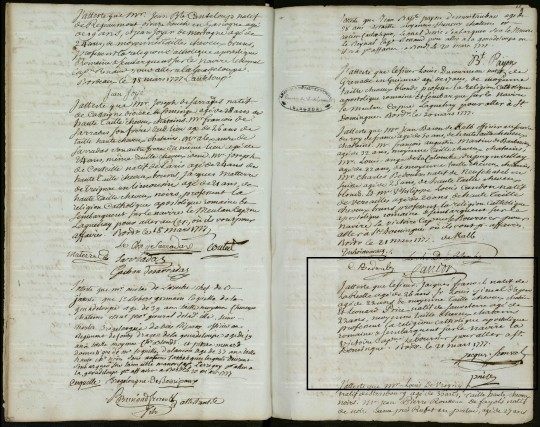
Archives départementales de la Gironde, Histoire maritime (1640-1889), Certificats de catholicité (1713-1787), 1777-1784 (07/29/2022).
Brice was a native of Annapolis, Maryland and the French papers tell us, that he was of average height for a man at the time (Moyenne taille). His hair colour was recorded as a dark blond (cheveux chatains). There is a small portraiture that survived of Brice.
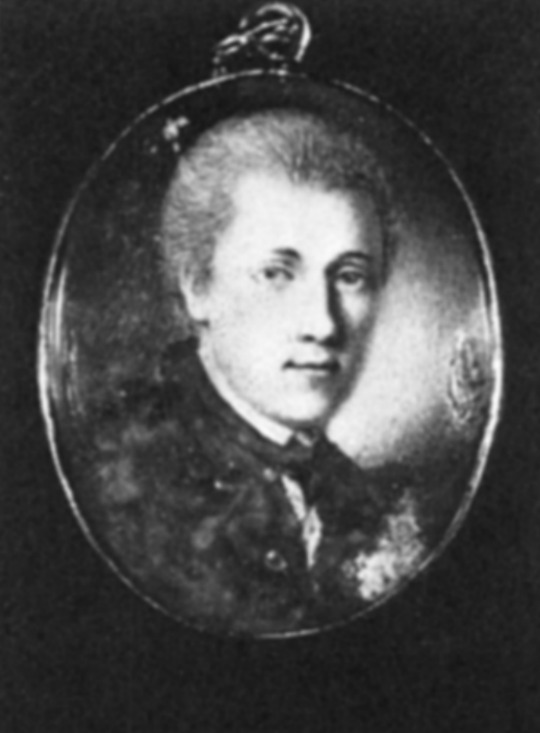
Idzerda Stanley J. et al., editors, Lafayette in the Age of the American Revolution: Selected Letters and Papers, 1776–1790, Volume 1, December 7, 1776–March 30, 1778, Cornell University Press, 1977, p. 50.
His age on March 21, 1777, the date of his Embarkation, is noted as 22 but that is wrong as well. Brice was born in 1751 (therefore being 26, not 22) and died in 1784 at the age of 33.
Brice had travelled to Europe to study art and painting and there he met La Fayette. In a letter from March 16, 1777 to John Hancock, Silas Deane wrote about Brice in the following terms:
I send you for your entertainment, by Mr. Brice, a young gentleman of Maryland, whom I think deserving your notice, as a worthy sensible young man, the London papers, in which you will perceive the character I have the honor of bearing in England, and that I have fled, &c. &c., which causes diversion here.
Idzerda Stanley J. et al., editors, Lafayette in the Age of the American Revolution: Selected Letters and Papers, 1776–1790, Volume 1, December 7, 1776–March 30, 1778, Cornell University Press, 1977, p. 33-34.
Brice left Paris on March 18 for Bordeaux where he arrived in time to embark onboard La Victoire on March 21. Given that he was American and was fluent in England, it is quite easy to imagine that La Fayette enjoyed his company during the crossing of the Atlantic. He wrote on April 19, 1777 in a letter to William Carmichael:
Thank you very much for having given me Mr. Brice. I like him very much, and he is popular with everyone. We shall always be together, as you seem to have desired.
Idzerda Stanley J. et al., editors, Lafayette in the Age of the American Revolution: Selected Letters and Papers, 1776–1790, Volume 1, December 7, 1776–March 30, 1778, Cornell University Press, 1977, p. 50.
After landing off the coast of Charleston, Brice was among the six officers that travelled with La Fayette and the Baron de Kalb to Charleston and from there to Philadelphia. While travelling, Brice functioned as a guide, although he was not familiar the area.
The Marquis's aide-de-camp took it upon himself to serve as our guide, even though he had no knowledge of that part of the country.
Memoirs of the Chevalier Dubuysson in Idzerda Stanley J. et al., editors, Lafayette in the Age of the American Revolution: Selected Letters and Papers, 1776–1790, Volume 1, December 7, 1776–March 30, 1778, Cornell University Press, 1977, p. 73-87.
In Philadelphia, La Fayette applied through John Hancock to George Washington to make Edmund Brice and three other man his aide-de-camps. These permissions were in the end granted although Washington was at first not that happy. Brice was commissioned a Major in 1777 and in October 1778 he was made a brevet lieutenant colonel by the Continental Congress. His promotion was noted in a letter from Henry Laurens to George Washington from October 30, 1778:

“To George Washington from Henry Laurens, 30 October 1778,” Founders Online, National Archives, [Original source: The Papers of George Washington, Revolutionary War Series, vol. 17, 15 September–31 October 1778, ed. Philander D. Chase. Charlottesville: University of Virginia Press, 2008, pp. 647–649.] (07/29/2022)
On October 16, 1778 La Fayette had written Congress to praise the actions of a soldier under his command and to ask Congress for promotions for his aide-de-camps. The letter was read in Congress on October 27, 1778 and resolutions were passed. The soldier that had distinguished himself (and had lost an arm in action) was awarded a livelong pension of 30 Dollar per month. Congress granted La Fayette’s American aide-de-camps, Brice and Neville, a promotion but not his French aide-de-camps. That in turn promoted La Fayette to write another letter on behalf of his French aide-de-camps to Congress on October 27, 1778.
Brice worked closely with La Fayette and often functioned as a liaison-officer between La Fayette and the Board of War or the Continental Congress (and in that aspect especially Henry Laurens). There are many instances where La Fayette writes that a certain letter will be or was delivered by Brice. Brice also once delivered a considerable number of congressional pamphlets from York Town to Washington’s headquarters. During the Battle of Gloucester, Brice’s horse was wounded. It also seems as if Brice was quite good when it came to decipher difficult handwritings. Henry Laurens wrote to La Fayette on March 6, 1778:
I cannot, even with Mr. Brice's aid, decypher the name coupled with that of Monsr. "Failly."
Idzerda Stanley J. et al., editors, Lafayette in the Age of the American Revolution: Selected Letters and Papers, 1776–1790, Volume 1, December 7, 1776–March 30, 1778, Cornell University Press, 1977, p. 336-338.
Brice had stayed some time with Laurens after delivering some papers to him and left on March 6, 1778. Brice also managed financial affairs, at one point affirming the receipt of 6000 Dollar in the name of the Marquis de La Fayette. At one point he also bought an enslaved man for La Fayette for the price of 180 Pounds on August 4, 1777.
It seems as if Brice quitted his post as La Fayette’s aide-de-camp after receiving his new commission on October 27, 1778.
Edmund Brice was the youngest child of his family. His older brother James Brice served in the War as well. He was first a Captain in the city militia and later a Lieutenant in the county militia. His services would earn him the honorary title of Colonel later on. I believe that Edmund married Harriet Woodward (born in 1762 and died in 1840) and they had a son, James Edmund Brice, together. Harriet remarried Alexander Murray after Brice’s death. The Brice’s were a very prominent family in Maryland at the time and it is sometimes difficult, especially with regard to biographical information, to know witch “Mr Brice” is talked about.
#marquis de lafayette#la fayette#24 days of la fayette#lafayettes aide-de-camps#french history#american history#letter#1777#1778#edmund brice#george washington#henry laurens#james brice#harriet woodward#founders online#maryland#american revolution
21 notes
·
View notes
Text
Iran. Many Iranian women opposed the Shah's autocratic rule and his use of a cruel secret police, SAVAK, which tortured many women who joined underground anti-government guerrilla groups. In 1978, militant Muslim supporters of Ayatollah Khomeini incited massive demonstrations against the Shah. To placate the religious leaders of the revolutionary movement, he banned abortion.
But in 1979, the militants drove him out. Khomeini, who had been propagandizing from exile in Paris, returned to Iran in triumph. In March 1979, 100,00 women gathered at the University of Tehran to celebrate the overthrow of the Shah and the Ayatollah’s victory. But almost at once, Khomeini suspended reformed family laws, barred women from becoming judges, issued his first order on the veil, passed a series of laws to segregate schools, buses, beaches, and other public areas, and established theocratic rule.
Disregarding women's support, the Ayatollah abolished all laws granting women rights and showed no reluctance to kill women who upheld them. He established a ‘morals police’—made up, in a rare exception, of women, called the Zeinab Sisters—to exercise surveillance on women's dress and behavior and harass or arrest them. One of his first acts was to prosecute the first woman member of the Iranian cabinet, Farrokhrou Parsa. Tried by judges in hoods, allowed no defense attorney and no appeal, she was in fact declared guilty before the trial began. Parsa was charged, writes Mahnaz Afhjami, with ‘expansion of prostitution, corruption on earth, and warring against God.’ Her actual offenses were to direct schoolgirls not to veil and to establish a commission to revise textbooks to present a nonsexist image of women. In December 1979, Khomeini had Parsa executed; she was wrapped in a sack and machine-gunned.
Women protested the new rules in massive marches in Teheran and other Iranian cities; men beat, stoned, and even stabbed them as they marched. Men purged women from the public realm, then passed laws severely restricting them from taking jobs and making it almost impossible for them to talk to or deal with men at work. In 1981, Khomeini had fifty schoolgirls shot and thousands of girls and women arrested for ‘counterrevolutionary’ or ‘anti-Islamic’ activity. None were given trials, and reports indicate that 20,000 women, including pregnant women, old women, and young girls, were executed. In 1982, Khomeini set the legal minimum age for execution at ten years (or puberty) for girls and sixteen for boys, banned women from most sports eventsand launched a new campaign of arrest, executing 15,000 people. That same year, he intensified government persecution of religious minorities, especially Jews and Baha'is. In 1983, he made veiling compulsory for women, and had ten women hanged for refusing to convert from Baha'i to Islam: three were teenagers; others included the first Iranian woman physicist, a concert pianist, the former personnel director for Iran Television, and nurse. He recruited children to clear minefields during Iran's war against Iraq; hundreds of thousands were killed.
In 1989, a woman interviewed on a television program said she would rather model herself on a contemporary woman than on Muhammad's daughter, the self-sacrificing Fatima who has been held up as a model for women for thirteen hundred years. Ayatollah Khomeini ordered those responsible for the program arrested and executed. When his advisers assured him the producers had made an innocent mistake, he granted pardons—but by then Iranian women had surely gotten the message.
“The War Against Women,” Marilyn French
2 notes
·
View notes
Text
How do you stop someone who can stop time?
I’ve been thinking about it a lot, especially in the context of the mha universe.
Quirks have advanced so far and so greatly that the possibility of someone eventually developing a literal time stopping quirk isn’t that outrageous.
Acting on the assumption that objects, people, animals and the weather is affected by the time freezing quirk and can only be moved if influenced by the quirk-user, that would be horrifically over powered and chaotic.
Imagine the things a person could do with that kind of power.

They have basically infinite money because they can just; 1) take small amounts of cash from a lot of random people in the street, adding up to hundreds or even thousands and most people probably wouldn’t notice such a small amount missing and 2) they could do the same thing, but with banks or large corporations
They could also steal objects, as long as it wasn’t that noticeable. Maybe a box of band aids and a bag of chips from one store and a microwave meal and a drink from another.
They can basically go anywhere with little to no consequences because camera don’t work properly and there are no eye witnesses because every one is frozen. As long as everything is put back in its place, no one would even know
They could sneak into any corporation; e.g. the hero commission and fine out all their dirty secrets, copy that information into their own notebook, put everything back neatly as they found it and then blackmail that corporation
They would have infinite time to read and absorb as much information as they want and basically become one of the most book-smart knowledgeable people in the city, possibly the country.
Even against someone like Aizawa, sure he would be able to use his quirk for a while and probably capture them, but the second he blinks and the person gets their quirk back? they’re long gone. They’re miles away having stolen hundreds of dollars.
They could kill anyone they wanted, slit their throats, and leave absolutely no evidence behind.
They would essentially be the equivalent of God herself
Granted if you have that kind of power, there would be drawbacks; both caused by the quirk itself and most likely psychological side effects;
Like the intense confusion of not knowing the date or time or not knowing how long you’ve been frozen since clocks and timers don’t work.
The panic of being like ‘how long have things been frozen? how long have I been here??’
things like that
also the quirk drawbacks
It would have to be something intense, to combat the sheer overpoweredness of the quirk itself
Like over time the longer you use it, the worse your migraine becomes until you can barely think or move and every step is agonising pain
or the more severely and quickly you start to loose blood from your nose, eyes and ears until you pass out and the quirk loses its effect
A/N: I love thinking about the logistics of quirks, makes my funny little nerd brain go ‘woo woo’.
#eggy writes*~#quirk#quirks#quirk analysis#bnha quirk#bnha quirks#bnha quirk analysis#boku no hero academia#my hero academia#mha quirk#mha quirks#mha quirk analysis#i love using my fun little lizard brain
18 notes
·
View notes
Text
"To accept the tutelage of the law yesterday, to reject it today and take it up again tomorrow, this is the way Catholics, socialists, parliamentarists in general act. It is illogical. None of their acts has a logical relation with that of the day before, no more than that of tomorrow will have one with that of today. Either we accept the law of majorities or we don’t accept it. Those who inscribe it in their program and seek to obtain the majority are illogical when they rebel against it. This is how it is. But when Catholics or socialists revolt we don’t seek the acts of yesterday; we don’t worry about those that will be carried out tomorrow, we peacefully look on as the law is broken by its manufacturers. It will be up to us to see to it that these days have no tomorrows.
So the anarchists alone are logical in revolt.The anarchists don’t vote. They don’t want to be the majority that commands; they don’t accept being the minority that obeys. When they rebel they have no need to break any contract: they never accept tying their individuality to any government of any kind. They alone, then, are rebels held back by no ties, and each of their violent gestures is in relation to their ideas, is logically consistent with their reasoning. By demonstration, by observation, by experience or, lacking these, by force, by violence, these are the means by which the anarchists want to impose themselves. By majority, by the law, never!
-Albert Libertad, "Down with the Law!" (1906)
...
"13. — Universal suffrage is one hypothetical manner of presuming the agreement of the masses, their resultant: in itself it is nothing, no more than the ballot box.
The sovereignty of the people is no more than the sovereignty of the prince, it is nothing. Justice is greater than both, independent of both.
14. — It follows that every popular plebiscite can be attacked in the name of right; that the homeland only exists for each on the condition of respecting right and that where right is collectively violated by the nation each citizen would have the right to oppose themselves to the nation, to repudiate its acts, and to declare themselves free towards it of every duty and commitment.
15. — In society, every citizen has right of government and right of justice. This right is never abdicated; the mandate is not a transfer of sovereignty; it is a commission.
Every election of representatives without a definition of its object is null.
There is no blank commission; that would imply a contradiction.
That is why the election of the representative, of the President, of the Emperor, is null. The mandate to command everything and do everything, in the name of the people, is absurd.
16. — Law results: 1) from public, prolonged, preliminary discussion, for the press, the meetings, etc.; — 2) from the discussion of the large associations; — 3) from their transaction. The law is not the will of anyone: the people are not infallible.
17. — The transaction is not the vote; the vote is only one means of arriving at a transaction. Every law voted for by 300 deputies, rejected by 150, is unjust.
The transaction is the compromise between the 300 and the 150.
18. — The transaction is the synthetic expression which results from all the opinions, for or against, expressed regarding the law.
19. — Every divergence of opinions leads to a synthesis, which is the general opinion, the actual law.
20. — The law is changing, depending on the state of the opinions, the divergence of which varies, and thus gives rise to a new transaction.
-P.-J. Proudhon, “What, Finally, is the Republic?” (1858)
...
“The people is sovereign only if each and everyone are themselves automatically sovereign, if not it is not the people that is sovereign but the state that by granting sovereingty is in fact the sovereign of the people. The state when claiming to be found on popular sovereignty claims in fact to be found on its abdication, its destitution. It follows that, if popular sovereignty is to be taken seriously, each and every assemblies, in all times, even composed of only one, are constituant assembly and that by extention there is of laws only the action of the people itself that is the action of each and everyone.”
-Me, "My tumblr blog" (2018 i think)
3 notes
·
View notes
Note
Now I have to block you because people on the right celebrate ignorance and Mooch of blue states. Them gunz ain't gonna feed your family......
I have posed this question a few times and never get a response
.... 🤔
Here is why I am a liberal...
Why are you a Republican?
The 40-hour work week, and thus, weekends!
Overtime pay and minimum wage.
Paid Vacations.
Women’s Voting Rights
The Civil Rights Act of 1964
The right of people of all colors to use schools and facilities.
Public schools.
Public libraries
Public transportation
Public universities
Public broadcasting
Public police and fire departments
Worker’s rights
Labor safety and fairness laws
*Nixon gave us the EPA
Child-labor laws.
The right to unionize
Health care benefits
National Parks, Monuments, and Forests, “America’s Best Idea”
Interstate Highway System (Eisenhower (R) and Al Gore Sr. (D)
Safe food and drugs (via the FDA)
Social Security
NASA
The Moon Landing and other space exploration
Satellites
The Office of Congressional Ethics.
The Internet
National Weather Service
Product Labeling/Truth in Advertising Laws
Rural Electrification/Tennessee Valley Authority
Bank Deposit Insurance
Centers for Disease Control and Prevention
Consumer Product Safety Commission
Consumer Financial Protection Bureau
Rights of the disabled (via Americans With Disabilities Act)
Family and Medical Leave Act
Clean air and water (Clean Air Act, Clean Water Act, the Environmental Protection Agency).
Civilian Conservation Corps
Panama Canal
Hoover Dam
The Federal Reserve
Medicare/Medicaid
The United States Military
The FBI
The CIA
Peace between Israel and Egypt
Peace between Israel and Jordan
Veterans Medical Care
Federal Housing Administration
Extending Voting Rights to 18 year olds
Freedom of Speech
Freedom of Religion/Separation of Church and State
Right to Due Process
Freedom of The Press
Right to Organize and Protest
Pell Grants and other financial aid to students
Federal Aviation Administration/Airline safety regulations
The end of slavery in the USA (The Emancipation Proclamation, The 13th Amendment)
Unemployment benefits
Smithsonian Institute
Americorps
Mandatory Food Labeling
Peace Corps
United Nations
World Health Organization
The Lincoln Tunnel
Sulfur emissions cap and trade to eliminate acid rain
Earned Income Tax Credit
The banning of lead in consumer products
National Institute of Health
Garbage pickup/clean streets
Banning of CFCs.
LGBT rights
Expanded voting access via polling places
Erie Canal
Bailout — and thus continued existence — of the American Auto Industry
Lily Ledbetter Fair Pay Act
Established the basis for Universal Human Rights by writing the Declaration of Independence
Miranda Rights
Banning of torture
The right to a proper defense in court
An independent judiciary
The right to vote
Dodd-Frank Wall Street Reform and Consumer Protection Act
Fair, open, and honest elections
The founding of The United States of America
The defeat of the Nazis and victory in World War II
Paramedics
Woman’s Right to Choose
The Civil Rights Movement
National Science Foundation
Vehicle Safety Standards
NATO
The income tax and power to tax in general, which have been used to pay for much of this list.
911 Emergency system
Tsunami, hurricane, tornado, and earthquake warning systems
The Freedom of Information Act
Water Treatment Centers and sewage systems
The Meat Inspection Act
The Pure Food And Drug Act
The Bretton Woods system
International Monetary Fund
SEC, which regulates Wall Street (weaked by conservatives)
National Endowment for the Arts
Campaign finance laws (weaked by conservatives)
Federal Crop Insurance
United States Housing Authority
School Lunch Act
Mental Retardation Facilities and Community Mental Health Centers Construction Act
Vaccination Assistance Act
The creation of counterinsurgency forces such as the Navy Seals and Green Berets.
Voting Rights Act, which ended poll taxes, literacy tests, and other voter qualification tests (weaked by conservatives)
The Brady Bill (5-day wait on handgun purchases for background checks)
Lobbying Disclosure Act
"Motor-Voter" Act
Civil Rights Act of 1968
Job Corps
Elementary and Secondary Education Act of 1965
Teacher Corps
Endangered Species Preservation Act of 1966
National Trails System Act of 1968
U.S. Postal Service
Modern Civilization
BIDEN WINS:
• Inflation Reduction Act
• CHIPS & Science Act
• PACT Act for veterans
• First major gun safety legislation in decades
• Took out the leader of al Qaeda
• Historic job growth (+12.8 million)
• Historically low unemployment
• Expanded the NATO alliance
• American Rescue Plan led to fastest jobs recovery in history
• Confirmation of Justice Ketanji Brown Jackson
• Rallied our allies in support of Ukraine
•Once-in-a-generation infrastructure investments
• Student loan forgiveness
• Rural broadband investment
In not a republican. I lean right on one issue. The second amendment. Why's that hard for leftists to comprehend
5 notes
·
View notes
Text
51 years later: Anna Marie Tilghman's widows pension

Tench Tilghman's gravestone, courtesy of Wikimedia.
Fifty-one years after Tench Tilghman's death, his wife (who was a cousin), Anna Marie Tilghman, got a widows pension. Tilghman was, as the Maryland State Archives argues, "one of Maryland's great patriots" due to his public service as part of a "commission established to form treaties with the Six Nations of Indian tribes," a captain in "the Pennsylvania Battalion of the Flying Camp.," and serving as an unpaid aide-de-camp to George Washington from August 1776 to May 1781 when Washington got him "a regular commission in the Continental Army." His final task was "he honor of carrying the Articles of Capitulation to the Continental Congress in Philadelphia." Other than that, the Maryland State Archives writes that Tench was
born on December 25, 1744 in Talbot County on his father's plantation. He was educated privately until the age of 14, when he went to Philadelphia to live with his grandfather, Tench Francis. In 1761, he graduated from the College and Academy of Philadelphia, which later became the University of Pennsylvania, and then went into business with his uncle Tench Francis, Jr. until just before the Revolutionary War. After the War, Tilghman returned to Maryland where he resumed his career in business in Baltimore and married his cousin, Anna Marie Tilghman. They had two daughters, Anna Margaretta and Elizabeth Tench. Tilghman died on April 18, 1786 at the age of 41.
His gravestone was placed in Talbot County's Oxford Cemetery long after his death. That's because he died at St. Paul's Church in Baltimore, with the remains brought from there to Talbot County in 1971 but the original gravestone, without the plaque, does tell something about him.
The widows pension by Anna Maria Tilghman tells an interesting story. [1] The first page shows that not only is it a penson for Anna Maria but that Tench also received a land grant, with "B.L.W.T." noting an "application for a warrant for bounty land" promised to him since he "served to the end of the war":

The next page notes that Tench died on April 18, 1786 in Talbot County, MD and was a Lieutenant Colonel serving in the army commanded by General George Washington, specifically in the Pennsylvania line, for two years. This is despite the fact he served for longer than two years as noted earlier in this article. For all of this, she would receive almost $4,000.00 a year, a sizable sum at the time when she was filing (May 1843):

The next page doesn't say much else other than that her claim would be processed in Maryland under the 1836 Pension Act covering veterans of the war with Britain from 1812-1815 and the Revolutionary War:

The page following is a personal appeal by her on February 24, 1837 in which she, before the Talbot County Orphans Court notes that she is the widow of Tench who serves as an Aide to Camp to George Washington and Lt. Colonel in the PA line, serving in total from January 1, 1777 to November 3, 1783. She also notes that she married Tench on June 9, 1783, and that he died on April 18, 1786:

The next page is a judge on the Orphans Court in Talbot County, James Price, certifying her declaration is correct, nothing more, nothing less:
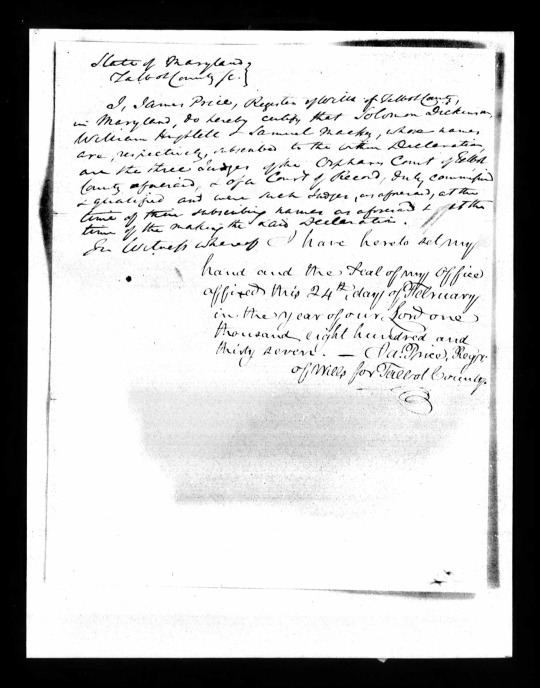
Then on March 11, 1837 a 82-year-old woman named Henrietta Maria Francis appeared before the Talbot County Orphans Court. She said she was "well acquainted with Col Tench Tilghman of Baltimore City," noting that she first met him in 1780, noting that through the years it was recounts how he was an aide-de-camp of George Washington. She was also, of course, familiar with Anna Maria Tilghman, saying that she was the daughter of one Matthew Tilghman, noting also that they were both married in June 1783. Clearly she was related on a familial level to Tench: her husband, Philip Francis, was Tench's uncle, whom Tench visited in March 1783 after their marriage.
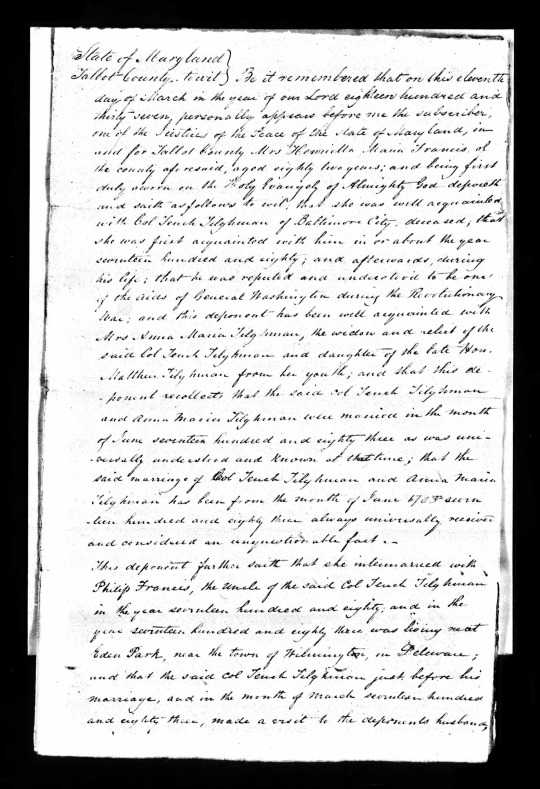
She adds that Tench died three years after she married Philip Francis, with Anna Maria (called she after this section) having one daughter before Tench's death, and another after Tench died (she must have been in labor when Tench died), and has since stayed as a widow. Others writing below her attest to the veracity of this statement:

By October 1858 it is asserted that Anna Maria died in 1843, with another Tilghman (M. Tilghman Goldborough) filing a continuing claim as they inherited her estate interestingly:
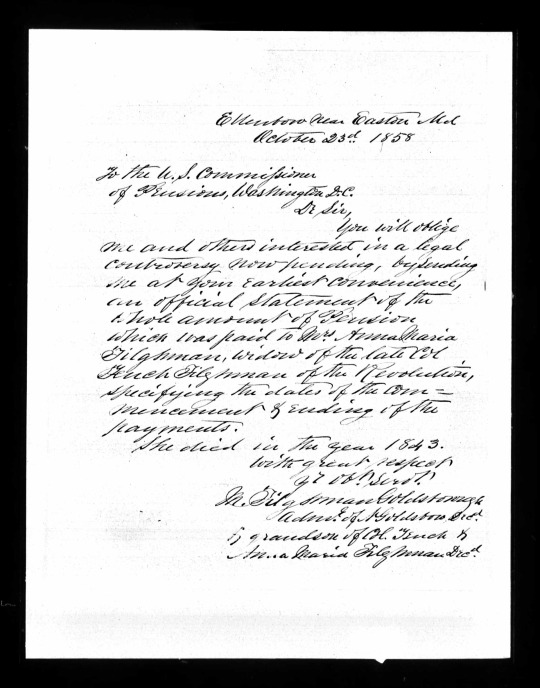
From there, Elizabeth Goldborough, likely the mother of the above listed M. Tilghman Goldsborough, turns out to be the daughter of Anna Maria and Tench! It is also noted that her sister is named Margaret who died, leaving her the only heir. This document, issued by a Talbot County Justice of the Peace in December 1825, shows that Margaret and Elizabeth were children of Anna Maria and Tench Tilghman without a doubt:
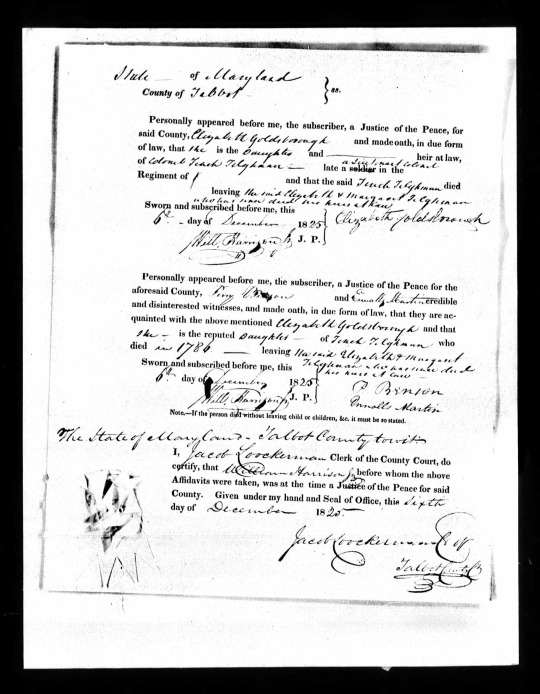
The pension goes on to say that Elizabeth is an heir of Tench Tilghman, and quickly notes Tench's military service:
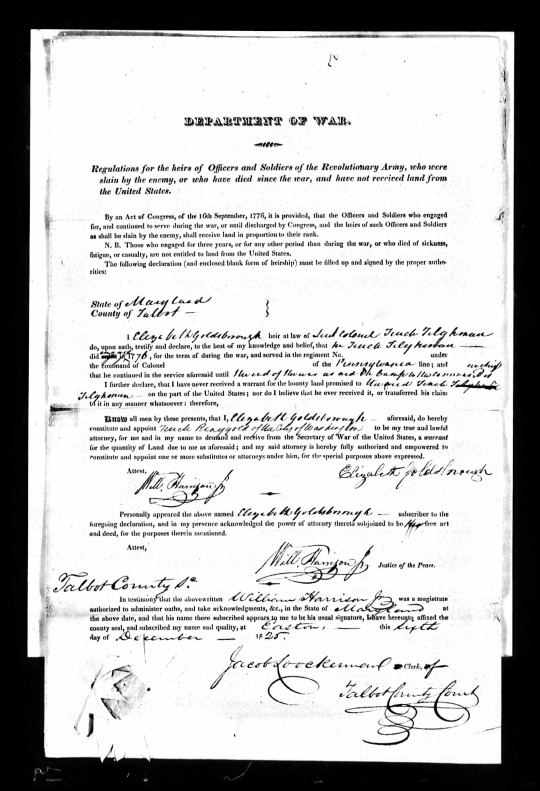
The next page makes it clear that all of those previous pages specifically related to a bounty land warrant claim, which is wrapped up within the pages of Tench's pension papers, making it possible for Tench's wife Anna Maria to apply for a widows pension in 1837 and Elizabeth to apply for the bounty land warrant in 1825, for her son to come back in the 1850s saying that now want to apply for the pension. This page makes it clear that Elizabeth's request was granted in January of 1826:
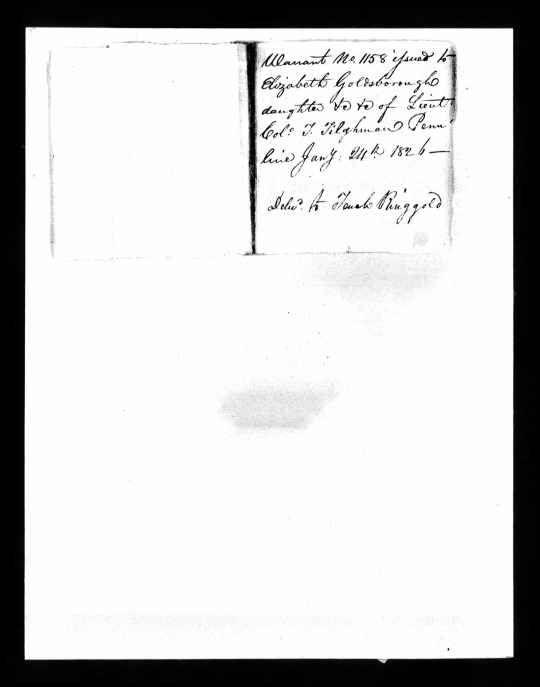
In May 1929, the War Department tried to sort all of this out. As they summarized, it was clear that Tench served from January 1, 1777 to November 3, 1783 as a Lieutenant Colonel in the Continental Army and an aide-de-camp to General Washington, dying on April 18, 1783. They also summarized how Tench married Anna Maria on June 8, 1783, allowed a pension on February 13, 1837but died on January 18, 1843. They also wrote that they had two children, Elizabeth and Margaret with the former child marrying a man named Goldsborough of Talbot County, Maryland, while the latter had a son named Tench Tilghman, marrying a man whose name is not yet known.

The final page says that a "grandson" named M. Tilghman Goldsborough is referred to in 1858 but no other family data is known.

The next page just notes Anna Maria's widows pension claim:

In May 1843, a man named Tench Tilghman said that he obtained a pension claim for a Mrs. Anna Maria Tilghman, widow of Tench in 1837, noting that Anna Maria died January 13, 1843 at age 88, if I read that right. He further notes that the youngest daughter of Anna Maria and Tench, Elizabeth ("Mrs. C.T. Goldsborough"), who was noted earlier, is an heir, while he is the son of the the older daughter, Margaret. As such, he asks the pension commissioner to whom the pension now belongs:
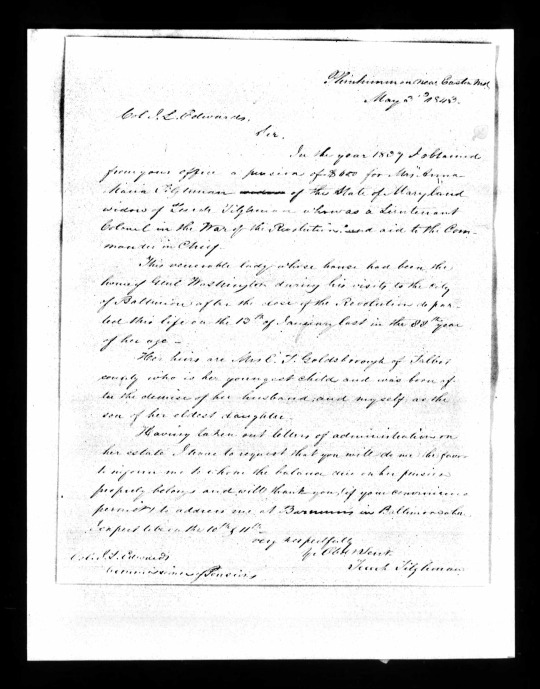
Then there is an earlier letter from J.L. Edwards, the pension commissioner in March 1837, saying that the papers in the case of the pension are returned as the evidence is "not being sufficient to establish the claim" because of new regulations on pensions. Perhaps this is what prompted the second Tench's letter in 1843, for which a response is not known:

A further letter from J.L. Edwards, in March 1837, confirms that Tench did serve from January 1, 1777 to November 3, 1783:
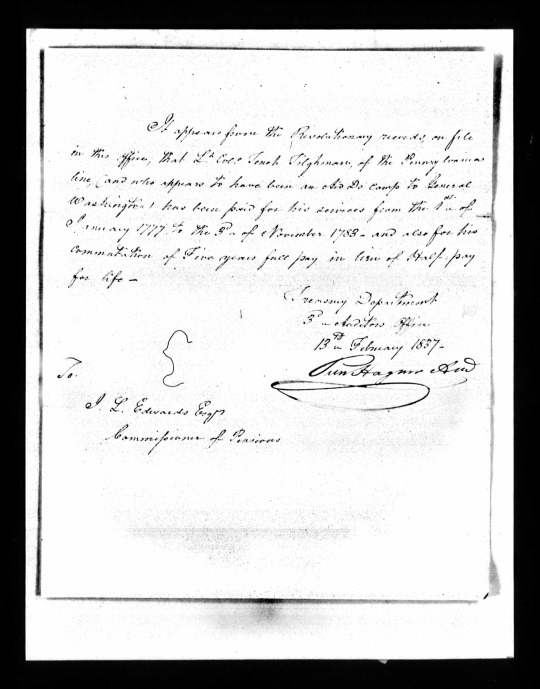
Then there is a letter from a later descendant in 1894 to the pension office about Tench's pension papers:

After that there is a 1928 letter by another descendant, Grace Cottingham Tilghman Bowen (who married a man named Charles Hay Bowen), leading to the response from the War Department as noted earlier in this post:
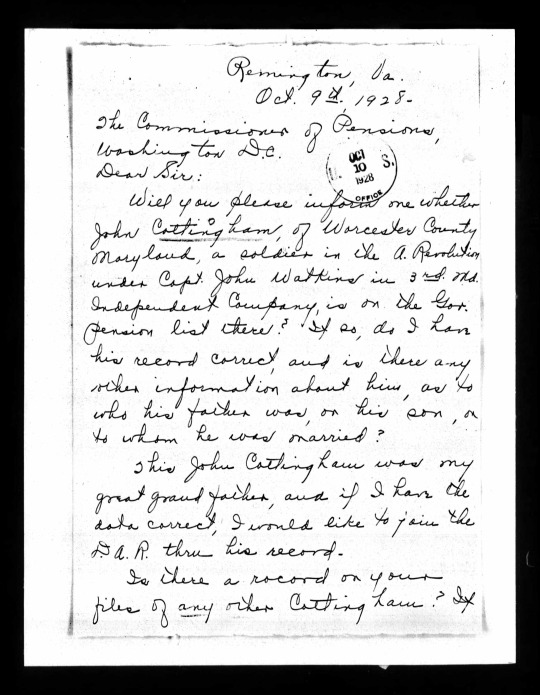
The second page specifically focuses on Tench:
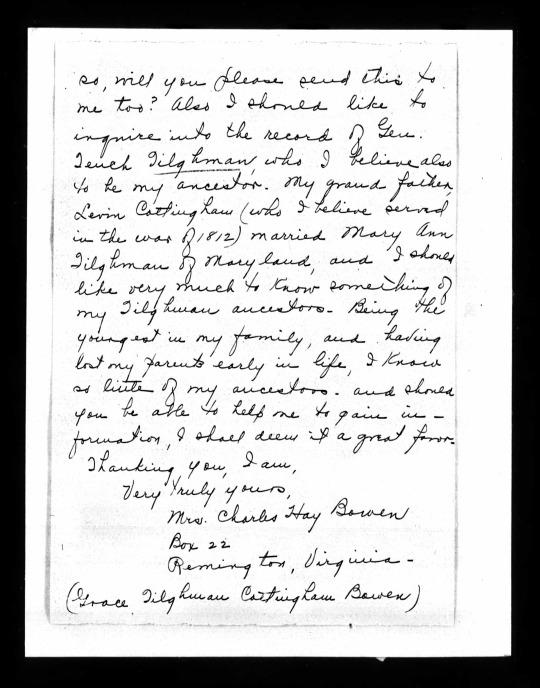
There is much to be learned from this pension. For one, that Tench served as a Lt. Colonel and Aide-De-Camp from 1777 to 1783, and that he married Anna Maria Tilghman, his cousin, in June 1783 when she was 28 years old (born in 1755). Furthermore, it is also clear that he had two children with her, Margaret (older) and Elizabeth (younger), with the latter child born after the "demise of her husband" Tench. From there, Margaret later had a child named Tench Tilghman, meaning that she married a person with the surname of Tilghman, while Elizabeth married a man named C.T. Goldsborough and seemingly had a child named M. Tilghman Goldsborough. It is not known when Margaret or Elizabeth died, but only that Margaret was dead sometime before 1825 (when Elizabeth filed her claim for the bounty land), while Elizabeth lived until at least 1843. Furthermore, it is also noted that Tench lived in Baltimore where he met a woman named Henrietta Maria Francis, who was 25 when she was first "acquainted" with Tench, and she married a man named Philip Francis,the uncle of Tench, whom Tench visited in March 1783 after the marriage of Henrietta and Philip. All of this calls for another post to dig into this more, which will be coming to you from this wonderful blog next week!
© 2017-2023 Burkely Hermann. All rights reserved.
Notes
[1] Pension of Tench Tilghman, 1837, B.L.Wt 1158-450, Widow's Pension Application File, W.9522, Revolutionary War Pension and Bounty-Land Warrant Application Files, National Archives, NARA M804, Record Group 15. Courtesy of Ancestry.com and Heritage Quest.
#gravestones#tench tilghman#wikimedia#pensions#military service#land grants#landowner#revolutionary war#american revolution#1830s#1780s#1770s#talbot county#marriage#cousins#estate#1850s#1840s#bounty land warrant#1820s#1890s#1920s
2 notes
·
View notes
Text
Top 7 MBA Best College In Delhi 2023 | Placements, Fees & many more.

You’ve come to the right spot if you’re looking for information about the MBA best college in Delhi. In this article, you’ll learn about the college’s placement, costs, and amenities, all of which will make it much easier for you to choose a college.
bloggingforu Provides You knowledgeable and Informational content.
Here is the list of MBA best college in Delhi.
7. New Delhi Institute of Management

The New Delhi Institute of Management is among Delhi’s top MBA best college in Delhi. The NDMI is regarded as a semi-private and private institute. In 1992, this institute was founded. ASIC has granted international accreditation to this institute’s MBA programme, which the AICTE stated in 2008.
The AICTE-CII has recognised NDMI as India’s Best Industry Linked Management Institute for two years in a row (2017–2018). Saket, Govindpuri, and GK-2 are the closest metro stations for transportation.
>Placements
The highest CTC offered in 2020 was 16.4LPA and the average is 8LPA. Over 240 companies visited the campus including Paytm, Oyo, Colgate, Amazon and so many others.
By seeing the results, this institute comes in the list of MBA best college in Delhi.
6. Indian Institute of Technology Delhi

Indian Institute of Technology Delhi is also comes in MBA best college in Delhi. The chairman of IIT is Dr. R. Chidambaram. IIT was established in August 1961.
Campus
1.Main campus
The main Campus of IIT Delhi is located in Hauz Khas, South Delhi. The area of campus is around 325 acres and is surrounded by the Hauz Khas area and monuments such as Qutab Minar and Lotus Temple.
2. Sonipat campus
The Sonipat Campus of IITD is announced in 2012 and unveiled in 2018 by the CM of Haryana. This campus was established at the cost of INR 175 crore.
3. Jhajjar campus
The Jhajjar campus of IITD is located next to the AIIMS-D Jhajjar campus at Badsa village in Haryana. IITD Jhajjar campus is funded by the IITD and managed by the FITT (Foundation of Innovation and Technology Transfer).
>Placements
The highest package for 2022 is INR 36.7LPA and the average package for 2022 is INR 21.9LPA.The packages of IITD are impressive. Therefore, IITD comes in the list of MBA best colleges in Delhi.
By seeing the results, this institute comes in the list of MBA best college in Delhi.
5. Amity University Noida

Now the Amity university Noida also to the list of MBA best college in Delhi. Amity University also goes by the names Amity University Uttar Pradesh or Amity University Delhi NCR.
Amity University is a private institution accredited by the NAAC with a rating of “A+.” It was formed in 2005 by an act of the State Legislature of the U.P. The WSCUC has also granted accreditation to this institution (WASC Senior College and University Commission). Along with other nations including London, Dubai, Singapore, and New York, it has campuses there as well.
It was the first private institution in India to introduce student scholarships based on merit and reservations. Around 80,000 students and 240 programmes were said to be enrolled at the institution in 2011.
>Placements
The highest package of 2022 is INR 12LPA which is the same as the previous year but the average package of 2022 is 14% more than the previous year which is INR 6.59LPA to INR 6LPA respectively.
This year more than 200 companies participated in placement at Amity University. By seeing the results, this institute comes in the list of MBA best college in Delhi.
CONTINUE READING : Top 7 MBA Best College In Delhi 2023 | Placements, Fees, Ranking, Cutoff
#MBA#college#delhi#mbaincanada#mba college in delhi#india best college#delhi college#bloggingforu#blogger
2 notes
·
View notes
Text
Kathryn Crosby actor and widow of Bing Crosby dies at 90
Reviews and recommendations are unbiased and products are independently selected. Postmedia may earn an affiliate commission from purchases made through links on this page.
Article content
LOS ANGELES — Kathryn Crosby, who appeared in such movies as “The 7th Voyage of Sinbad,” “Anatomy of a Murder,” and “Operation Mad Ball” before marrying famed singer and Oscar-winning actor Bing Crosby, has died. She was 90.
Article content
She died of natural causes Friday night at her home in the Northern California city of Hillsborough, a family spokesperson said Saturday.
Appearing under her stage name of Kathryn Grant, she appeared opposite Tony Curtis in “Mister Cory” in 1957 and Victor Mature in “The Big Circus” in 1959. She made five movies with film noir director Phil Karlson, including “Tight Spot” and “The Phenix City Story,” both in 1955.
Her other leading men included Jack Lemmon in “Operation Mad Ball,” James Darren in “The Brothers Rico,” and James Stewart in “Anatomy of a Murder,” directed by Otto Preminger.
Born Olive Kathryn Grandstaff on Nov. 25, 1933, in West Columbia, Texas, she graduated from the University of Texas with a degree in fine arts. She came to Hollywood and began her movie career in 1953.
Article content
We apologize, but this video has failed to load.
Play Video
She met Bing Crosby while doing interviews for a column she wrote about Hollywood for her hometown newspaper. They were married in 1957, when she was 23 and he was 54.
She curtailed her acting career after the wedding, although she appeared often with Crosby and their three children on his Christmas television specials and in Minute Maid orange juice commercials. She became a registered nurse in 1963.
In the 1970s, she hosted a morning talk show on KPIX-TV in Northern California.
After Crosby’s death at age 74 in 1977, from a heart attack after golfing in Spain, she appeared in stage productions of “Same Time, Next Year” and “Charley’s Aunt.” She co-starred with John Davidson and Andrea McArdle in the 1996 Broadway revival of “State Fair.”
For 16 years ending in 2001, she hosted the Crosby National golf tournament in Bermuda Run, North Carolina.
She is survived by children Harry, Mary, an actor best known for the TV show “Dallas,” and Nathaniel, a successful amateur golfer. She was married to Maurice Sullivan for 10 years before he was killed in a 2010 car accident that seriously injured Crosby.
Share this article in your social network
Source link
via
The Novum Times
0 notes
Text







On August 6th 1796,the Scottish artist David Allan died, he was known as The Scottish Hogarth.
Allan was born in what once was the busy port of Alloa on the river Forth where his father, also David, was the Shoremaster in charge of the harbour.
David had a rather unfortunate childhood; he was born prematurely and his mother died shortly after his birth, he survived two accidents in his early years which threatened his life. He displayed an early talent for drawing which led to his expulsion from the parish school when he drew a caricature of the dominie in the act of caning unruly pupils, dominie is an old Scottish name for a schoolmaster.
In 1753, Robert Foulis, a publisher in Glasgow, founded the Academy of Art and Design which was granted a room in Glasgow University. The Academy was essentially a charitable institution supported by local wealthy merchants with encouragement from the aristocracy including the Duke of Argyle and Lord Cathcart. In 1755, two years after its foundation it had only ten pupils who paid 1½ guineas a session. In that year David Allan entered the Academy at the age of eleven as an apprentice bound to Robert Foulis for a period of seven years. He was supported no doubt by Lord Cathcart whose estate, Schawpark, was adjacent to Alloa. Lord and Lady Cathcart became aware of Allan’s artistic ability at an early age and gave him encouragement and financial support throughout their lives.
The Academy enjoyed only a brief existence until 1775 when financial difficulties led to its closure but during its short life it fostered a number of young students who rose to eminence including David Allan and his close friend and contemporary James Tassie. Allan completed his apprenticeship and continued to study at the Academy for a further two years becoming a master of the skills of engraving and etching.
To complete his education, it was felt that Allan should attend one of the continental schools. In 1767 he moved to Rome, where he lived for ten years; this was the most successful period of his life. In Rome, Allan painted ambitious historical pictures, portraits, caricatures and genre scenes. On returning to London in 1777, he spent two years trying to establish himself. Unsuccessful and ill, he returned to Scotland where he specialised in painting family groups. He also produced book illustrations and was appointed the master of the Trustees' Academy at Edinburgh, as well as illustrations for publications by Robert Burns and Allan Ramsay.
Allan collaborated with Burns through George Thomson: with the 1793 commission for Thomson’s song collection, the artist produced more than 100 drawings in oval format. Burns saw in Allan’s work a spirit similar to his own. The poet wrote to Thomson in November 1794:
I look on myself to be a kind of brother-brush with him. – “Pride in Poets is nae sin”, & I will say it, that I look on Mr Allen & Mr Burns to be the only genuine & real Painters of Scotish Costume in the world!
Burns owned a copy of Allan Ramsay’s The Gentle Shepherd as published by Foulis in Glasgow in 1788. . In 1794 he described David Allan as a “man of very great genius”, and marvelled that he was not better known than he was.
Allan married Shirley Welsh, herself a keen art student, and a great admirer of her husband’s work, they had five children only one of whom, Barbara, reached adult life.
Burns died on 21st July, and was closely followed by Allan, on 6th August 1796.
Allan is buried in the Old Calton Cemetery, Edinburgh, not far from the grave of David Hume.
The first three pics are from my visit to The Scottish National Portrait Gallery las week, the others are from the ilustrations he drew for Burns, my favourite being the "Battle of Killiecrankie" one, another link to a recent post. The final pic is also my own from a visit to Old Calton Burial Ground.
8 notes
·
View notes
Text
Baze University Receives NUC Accreditation for Nursing Programme
Baze University Receives NUC Approval for BSc Nursing Programme
The National Universities Commission (NUC) has officially granted accreditation for the establishment of a Bachelor of Science in Nursing (BScN) programme at Baze University, Abuja. This significant approval was detailed in a letter dated 17th September 2024, signed by Abubakar M. Girei, the Acting Director of Academic Planning, on…
0 notes
Text
Your college , Your future.
Welcome
Sunrise University is situated on a sprawling campus of 35 acres in the National Capital Region Alwar which is also known as “Tiger Gate of Rajasthan”. It is established under Sunrise University Act, 2011 (Act No. 25 of 2011) and recognized by University Grant Commission u/s 2(f) of UGC Act, 1956. It is a multi-facility University, with jurisdiction spread over the state of Rajasthan.

1 note
·
View note
Text
Recent school fees increment by FG, Lagos illegal – Falana

Human Rights lawyer, Femi Falana, SAN, has condemned the recent increment in school fees by the federal and Lagos state governments, describing the development as illegal.
Vanguard reports that the federal government had in July 2023 increased fees for Unity Schools from N45,000 to N100,000 per term, an increase by over 120%. In a similar fashion, the Lagos State government, yesterday, announced N100,000 as the new fees for state-owned boarding schools. It was previously N35,000.
Falana’s reaction, weekend, described it as a violation of the Child’s Rights Act and Lagos State Child’s Rights Law. He lamented that with the increase being above the minimum wage of N70,000, “a worker can no longer sponsor even one child either in the Unity School or any secondary school in Lagos State.” He vowed to challenge the decision in the appropriate High Courts.
He wrote, “The federal government has increased fees payable in all unity schools from N45,000 to N100,000 per term. Thus, the fee payable per annum is N300,000 per student.
“Similarly, the Lagos State Government has fixed fees payable in all secondary schools at N100,000 per term or N300,000 per annum by every student.
“At N70,000 minimum wage, the salary of a worker per term of 4 months is N280,000. The implication is that a worker can no longer sponsor even one child either in the Unity School or any secondary school in Lagos State.
“However, under the Child’s Rights Act and Lagos State Child’s Rights Law, every child is entitled to free & compulsory education from primary school to junior secondary school. To that extent, the imposition of N100,000 Fee on students in junior secondary schools in Unity Schools and secondary schools Lagos State is illegal.
“In view of the clear provisions of the Child’s Rights Laws applicable in all states of the Federation and the Federal Capital Territory, the illegal imposition of prohibitive fees on junior secondary school students will be challenged in the appropriate High Courts.
“Meanwhile, on July 10, 2024, the Executive Secretary of Universal Basic Education Commission (UBEC), Dr. Hamid Bobboyi revealed that over N45.7 billion matching grant to state governments for the implementation of Universal Basic Education (UBE) between 2020 and 2023 has not been accessed by many states governments.”
“So I really want to encourage the company. It is really amazing that we have this type of manufacturing going on here. This is the same company that is trying to build the industrial park in Idu, and we are going to give them all the necessary support. Just yesterday, I sent out a letter to the Ministry of Finance to get some tax credit to enable them to carry out the other one-carrier way to make it a double carriage,” he stated.
Read the full article
0 notes
Text
LGB Alliance are trying to legally discriminate again
New Post has been published on https://qnews.com.au/lgb-alliance-events/
LGB Alliance are trying to legally discriminate again
Using The Peel as a reason they should be able to discriminate, the LGB Alliance are in court again.
The acronym LAG is appropriate for the Lesbian Action Group based in Victoria.
They are once again in the news trying to exclude transgender and bisexual women from their social events legally.
During hearings in Melbourne last week, The Guardian reported LAG’s efforts to have last year’s decision by the Australian Human Rights Commission not allowing them to discriminate overturned.
LAG’s seven members claim they need a legal exemption to hold public events for the advocacy and well-being of lesbian feminists.
In court, their lawyer compared their request to the exemption that allows The Peel Hotel to exclude heterosexuals.
A lawyer for the Australian Human Rights Commission stated The Peel Hotel’s exemption is granted under Victorian state law to help gay men achieve equality.
They also stated that the Lesbian Action Group’s application is being used to discriminate against transgender women.
LAG maintain that transgender women are men.
In 2013 the Sex Discrimination Act was amended to protect all LGBTIQ+ people, including trans women and non-binary people from unfair treatment.
If LAG were to hold their events privately, they would not be subject to these laws.
‘We are seeking to discriminate.’
“We are seeking to discriminate,” LAG’s counsel Leigh Howard told the tribunal, “We’re female, and we’d like some rights, please.”
“There’s nothing anti-trans about our application at all.” LAG’s Carole Ann said.
Citing that young lesbian feminists “are so isolated, they have no one else to talk to and they don’t know where to find the support.”.
The Lesbian Action Group’s website directs people to multiple online events per month to connect.
Former University of Melbourne professor of political science and lesbian feminist scholar Sheila Jeffreys spoke to the tribunal from the UK.
“When men claim to be women, a clash of rights exists because women have existing human rights as women.”
She said she feared the 2013 amendments to the Sex Discrimination Act “make the law an ass”.
A decision regarding this matter is expected to be announced by the end of the year.
Here we are outside the Tribunal building. Such a dangerous nazi looking mob of terfs!! Or are we an irrelevant bunch of old women who should just go quietly back into our closet? Make up your mind AHRC. pic.twitter.com/1TFvoFpTjv
— Lesbian Action Group (@ActiveLesbians) September 5, 2024
Not the first time
This is not the first time LAG has sought to lawfully discriminate against the Sex Discrimination Act.
In August 2023, the Australian Human Rights Commission rejected their application to hold a social event at the Victorian Pride Centre that excluded transgender and bisexual women.
The Victorian Pride Centre is the home of our community support and health services, including Transgender Victoria.
The event was declined as it was “inconsistent with the Pride Centre’s purpose”.
In their statement, The Victorian Pride Centre cited LAG sought to “legally discriminate against people on the basis of their sex, sexuality and gender’.
LAG applied for a temporary exemption from anti-discrimination laws for one event and a general exemption for five years.
The application was rejected
The application was inconsistent with the objects of the Sex Discrimination Act protecting all LGBTIQ+ people from unfair treatment.
For the latest LGBTIQA+ Sister Girl and Brother Boy news, entertainment, community stories in Australia, visit qnews.com.au. Check out our latest magazines or find us on Facebook, Twitter, Instagram and YouTube.
0 notes